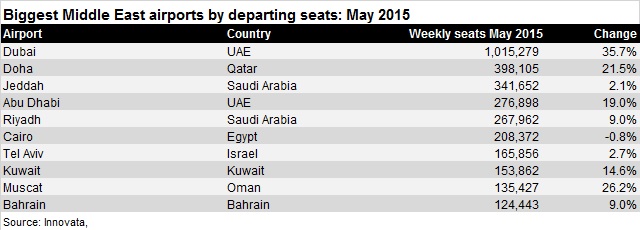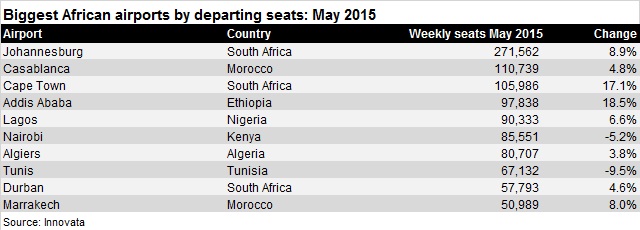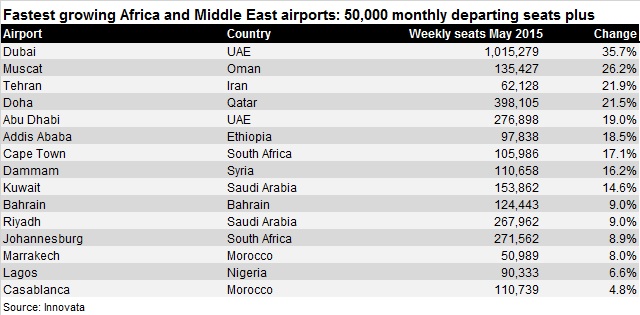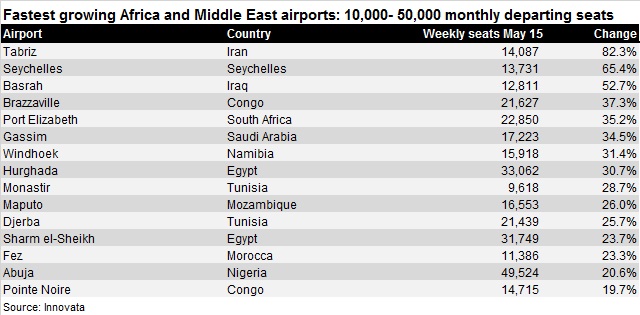Gulf carrier strategy continues to drive much of the growth for airports in the Middle East and Africa, though expansion in the region runs well beyond their home bases.
Preliminary passenger data for 2014 from airports grouping ACI World shows nine gateways in the Africa and the Middle East region among the 150 biggest by passenger number.
These airports, dominated by the big Gulf and Saudi hubs, handled a combined 223 million passengers last year. This accounts for a 14% share of passengers across the 150 biggest airports.

Given the rapid growth of their respective home carriers, it comes as little surprise to see the Gulf giants' hubs leading the way in scale and growth in the Middle East.
Weekly seat data in May from Flightglobal's schedules specialist Innovata shows Emirates' Dubai base as having well over double the number of departing seats of its next-biggest rival, Doha. This reflects that Emirates, now in its 30th year, has been operating for longer than either Qatar Airways or Etihad Airways. Indeed, despite its current rapid expansion – capacity increased a fifth at Abu Dhabi in May – the hub of the Etihad partnership strategy was still only the fourth biggest airport in May by capacity.

Growth at Dubai International in May is distorted by the extended runway closure due to construction work last summer. Dubai's main airport cut a quarter of its aircraft movements for an 80-day period in order to proceed with a runway renovation programme. Eight carriers shifted flights to Dubai Al Maktoum airport during the work.
Dubai Airports will begin work later this year on an expansion of Al Maktoum's passenger terminal to increase capacity from the current six million passengers a year to 26 million. The upgrade is to be completed by the end of the first quarter of 2017, and is a precursor to an $32 billion project to raise capacity at Al Maktoum beyond 200 million passengers per year.
Flightglobal's Innovata data shows the South African pair of Johannesburg and Cape Town, together with Casablanca in Morocco, as the biggest African airports by capacity in May.
This includes growth of 17% in departing seats at Cape Town, driven by expansion on a number of domestic routes and international services, including Emirates service from Dubai.

Capacity has also been increased almost a fifth in May at Addis Ababa, the base of Ethiopian Airlines, compared with a year ago, Innovata schedules show. The carrier's new routes include Dublin and Los Angeles this summer.
Excluding the runway-impacted changes at Dubai, the fastest growing among airports handling more than 50,000 departing seats in May across both Africa and the Middle East were Muscat in Oman and Tehran in Iran.
Alongside the big Gulf hubs, airlines also lifted capacity sharply at Dammam, Kuwait, Bahrain and Riyadh in May compared with a year ago.

One of the notable fastest growing among smaller airports is the Seychelles, where capacity has been increased almost two-thirds compared with May 2014, Innovata data shows.
This was in part driven by Air Seychelles, which has been growing sharply since being taken under Etihad's wing. Air Seychelles lifted its capacity a fifth compared with May last year, including new routes to Dar es Salaam, Madagascar and Mumbai. It will also switch its Paris Charles de Gaulle flights to a direct service in July.

Source: Cirium Dashboard
















